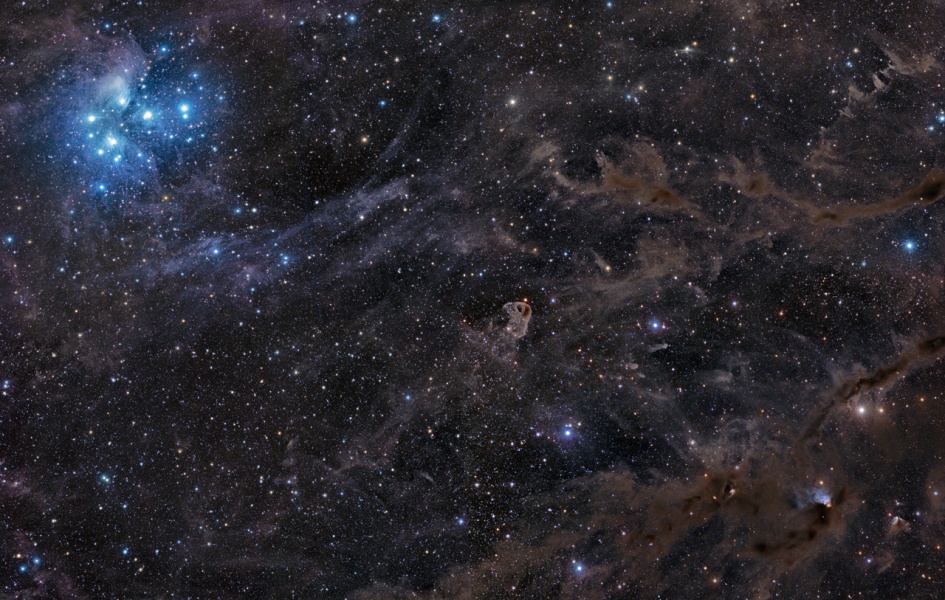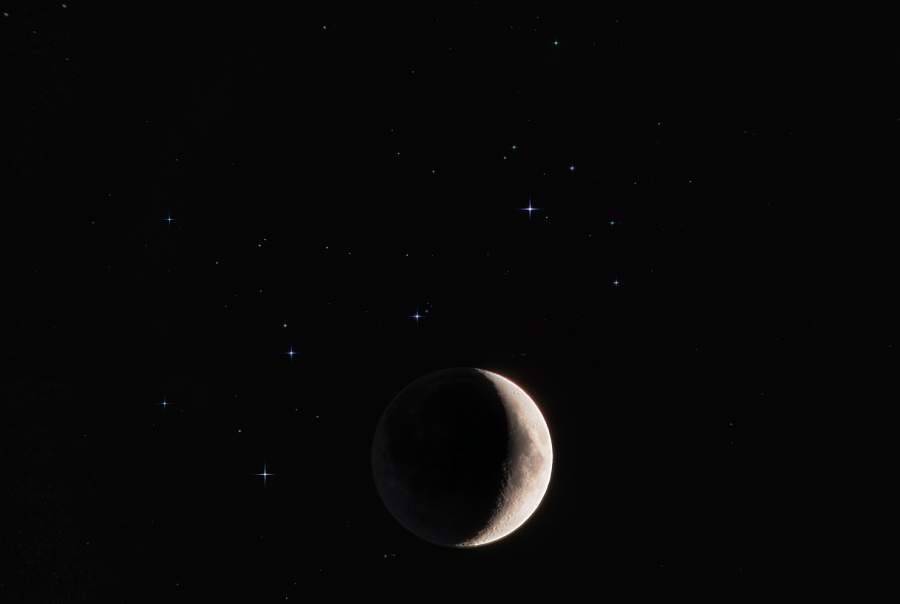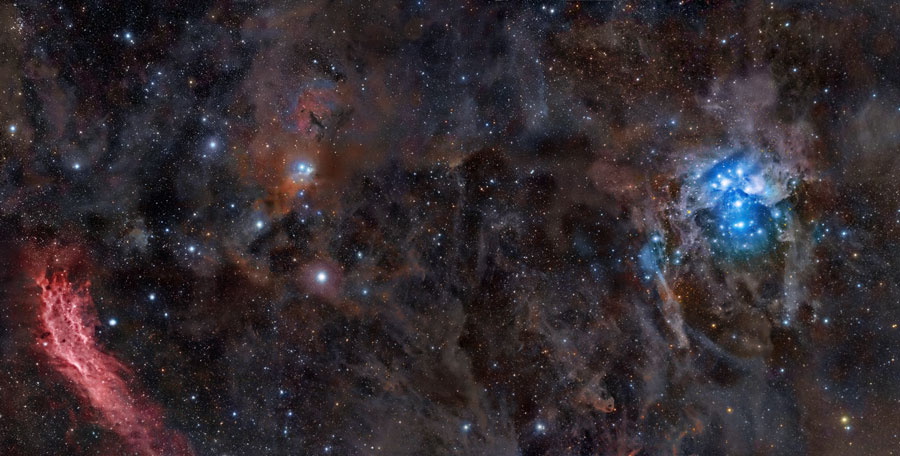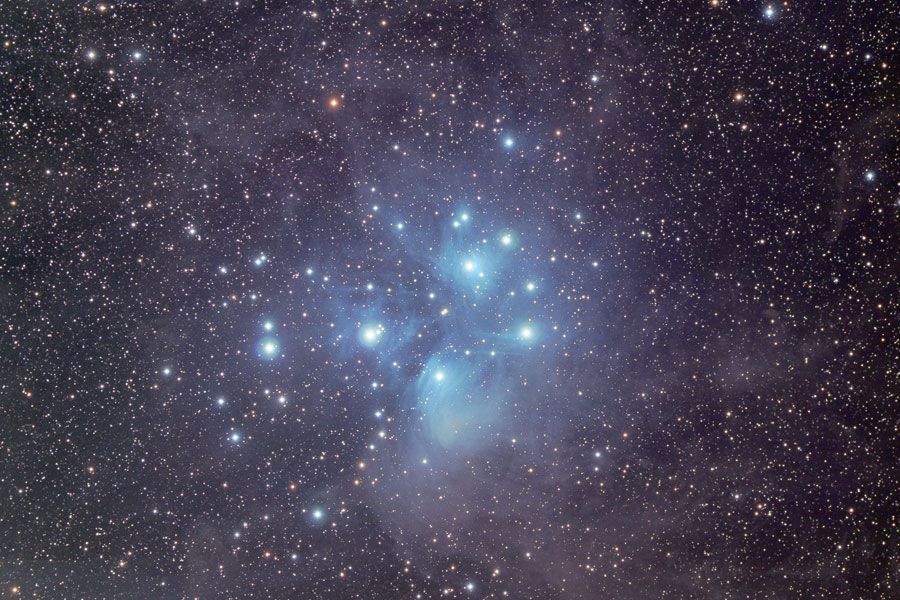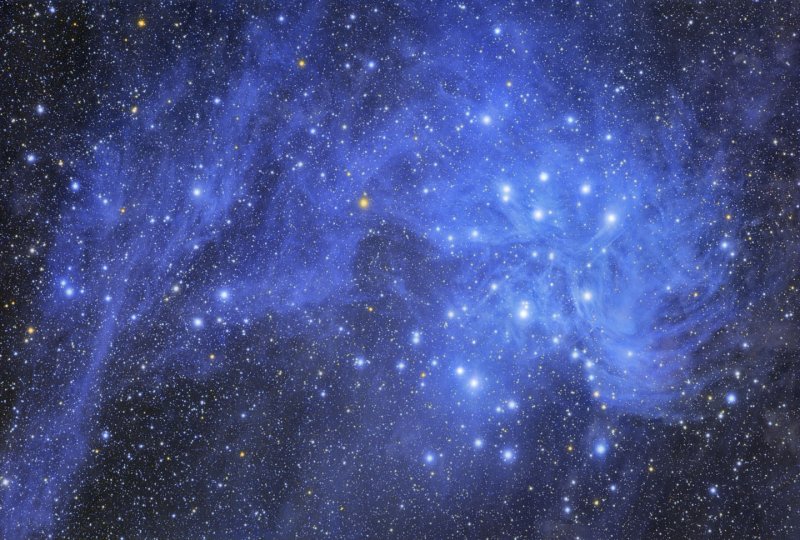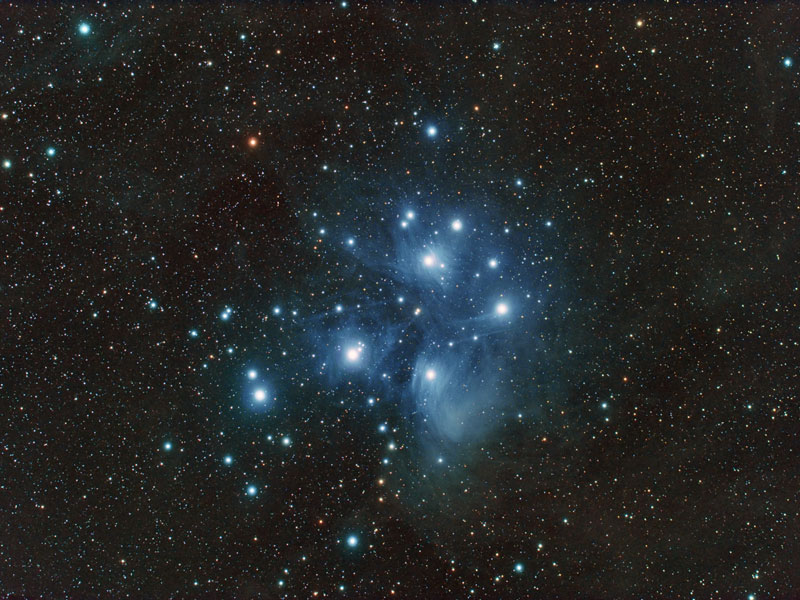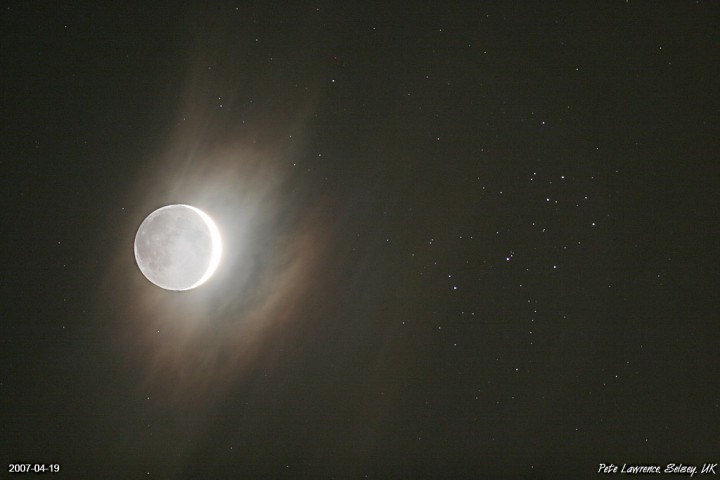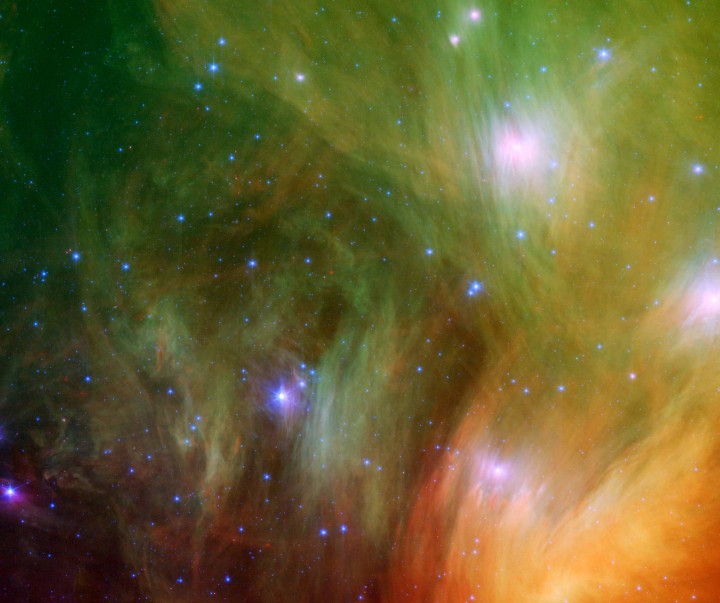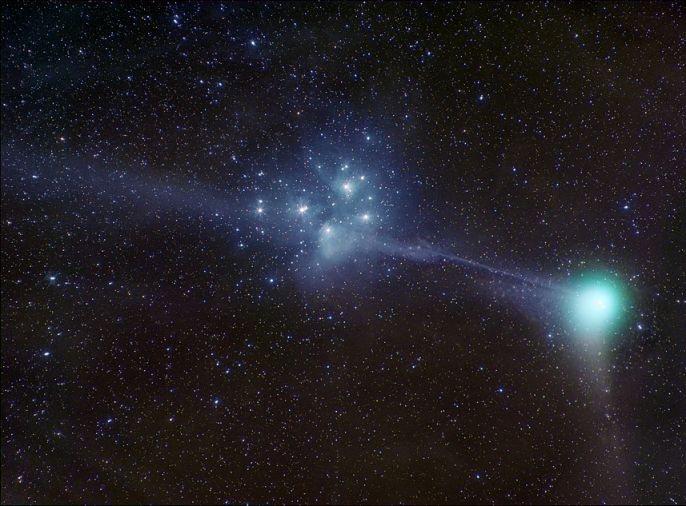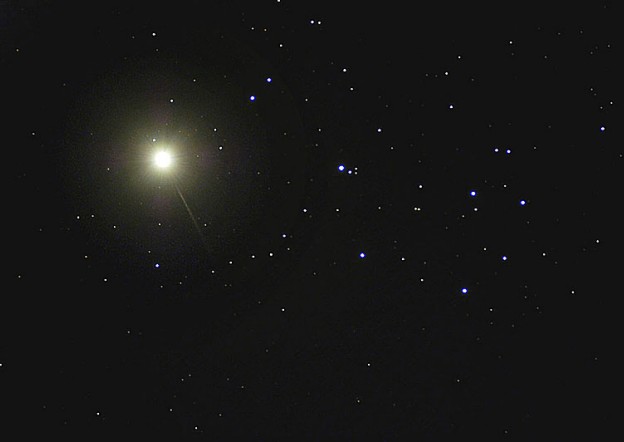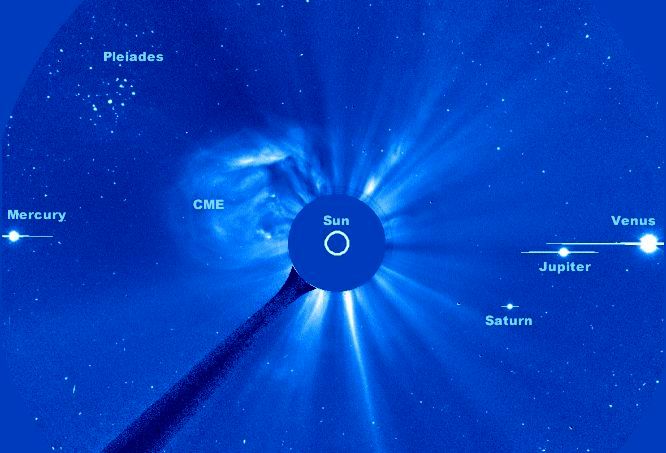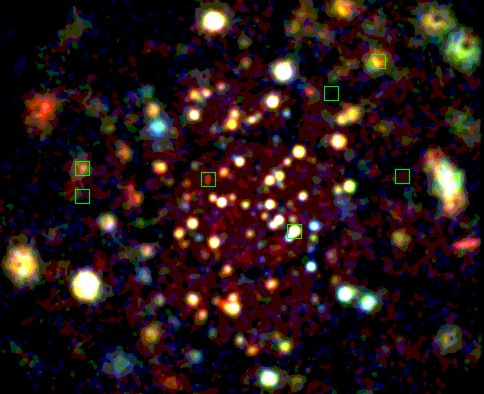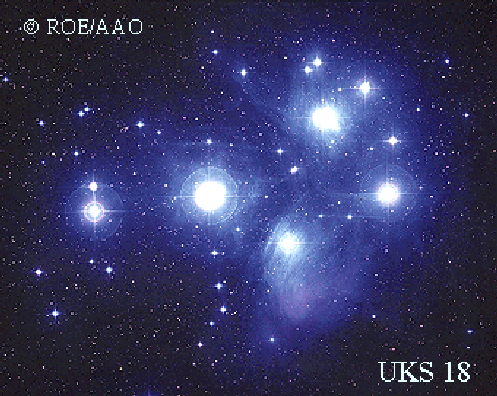M45: The Pleiades Open Star Cluster
All titles are clickable and link to the original APOD page. Click on an image for a larger view of it.
An Introductory Astronomy lecture on star clusters is available here.
2011 January 3
[imghover6=http://apod.nasa.gov/apod/image/1101/wi ... stlake.jpg]http://apod.nasa.gov/apod/image/1101/wi ... otated.jpg[/imghover6]Credit & Copyright: Jimmy Westlake (Colorado Mountain College)
2010 November 18 Hurtling through a cosmic dust cloud some 400 light-years away, the lovely Pleiades or Seven Sisters star cluster is well-known for its striking blue reflection nebulae. In the dusty sky toward the constellation Taurus and the Orion Arm of our Milky Way Galaxy, this remarkable image shows the famous star cluster at the upper left. But lesser known dusty nebulae lie along the region's fertile molecular cloud, within the 10 degree wide field, including the bird-like visage of LBN 777 near center. Small bluish reflection nebula VdB 27 at the lower right is associated with the young, variable star RY Tau. At the distance of the Pleiades, the 5 panel mosaic spans nearly 70 light-years.
2010 March 26 A young crescent Moon shares the western sky with sister stars of the Pleiades cluster in this pretty, evening skyscape recorded on the March equinox from San Antonio, Texas. In the processed digital image, multiple exposures of the celestial scene were combined to show details of the bright lunar surface along with the Pleiades stars. Astronomical images of the well-known Pleiades often show the cluster's alluring blue reflection nebulae, but they are washed-out here in the bright moonlight. Still, during this particular night, skygazers in South and Central America could even watch the 5 day old Moon occult or pass in front of some of the brighter Pleiades stars.
2009 November 3 On the upper right, dressed in blue, is the Pleiades. Also known as the Seven Sisters and M45, the Pleiades is one of the brightest and most easily visible open clusters on the sky. The Pleiades contains over 3,000 stars, is about 400 light years away, and only 13 light years across. Surrounding the stars is a spectacular blue reflection nebula made of fine dust. A common legend is that one of the brighter stars faded since the cluster was named. On the lower left, shining in red, is the California Nebula. Named for its shape, the California Nebula is much dimmer and hence harder to see than the Pleiades. Also known as NGC 1499, this mass of red glowing hydrogen gas is about 1,500 light years away. Although about 25 full moons could fit between them, the above wide angle, deep field image composite has captured them both.
2008 December 9 Perhaps the most famous star cluster on the sky, the Pleiades can be seen without binoculars from even the depths of a light-polluted city. Also known as the Seven Sisters and M45, the Pleiades is one of the brightest and closest open clusters. The Pleiades contains over 3,000 stars, is about 400 light years away, and only 13 light years across. A prominent telescope and car company has borrowed the star cluster's name. Quite evident in the above photograph are the blue reflection nebulae that surround the brighter cluster stars. Low mass, faint, brown dwarfs have also been found in the Pleiades.
2007 November 22 Hurtling through a cosmic dust cloud a mere 400 light-years away, the lovely Pleiades or Seven Sisters star cluster is well-known for its striking blue reflection nebulae. This remarkable wide-field (3 degree) image of the region shows the famous star cluster at the right, while highlighting lesser known dusty reflection nebulae nearby, across an area that would span over 20 light-years. In this case, the sister stars and cosmic dust clouds are not related, they just happen to be passing through the same region of space. But astronomers using infrared detectors have recently found a dusty disk that really does belong to one young Pleiades star -- HD 23514. Surrounding HD 23514, the disk is estimated to be comparable in size to the terrestrial planet zone in our own solar system and likely represents the debris from the process of rocky planet formation.
2007 November 18 Perhaps the most famous star cluster on the sky, the Pleiades can be seen without binoculars from even the depths of a light-polluted city. Also known as the Seven Sisters and M45, the Pleiades is one of the brightest and closest open clusters. The Pleiades contains over 3000 stars, is about 400 light years away, and only 13 light years across. Quite evident in the above photograph are the blue reflection nebulae that surround the brighter cluster stars. Low mass, faint, brown dwarfs have also been found in the Pleiades.
2007 June 11
2007 April 28 A young crescent Moon shared the western sky with thin clouds and the sister stars of the Pleiades cluster in this early evening skyscape recorded on April 19th. Astronomical images of the well-known Pleiades often show the star cluster's alluring blue reflection nebulae, but they are washed-out here in the clouds and bright moonlight. While the 3-day old Moon is overexposed, surface features can be seen on the dim lunar night side, illuminated by earthshine - light from sunlit planet Earth. Only a week earlier, brilliant Venus also posed near the sister stars. Of course, Venus has not yet wandered too far from the Pleiades and still rules western skies as the evening star.
2007 April 13 Hurtling through a cosmic dust cloud a mere 400 light-years away, the lovely Pleiades or Seven Sisters star cluster is well-known in astronomical images for its striking blue reflection nebulae. At visible wavelengths, the starlight is scattered and reflected by the dust, but in this portrait in infrared light by the Spitzer Space Telescope, the dust itself glows. The false color image spans about 1 degree or seven light-years at the distance of the Pleiades, with the densest regions of the dust cloud shown in yellow and red hues. Exploring this young, nearby cluster, the Spitzer data have revealed many cool, low mass stars, brown dwarfs or failed stars, and possible planetary debris disks. Want to see the Pleiades tonight? Look near Venus, the brilliant evening star in the west just after sunset.
2006 July 15
[img6="Credit: Hubble Heritage Team, George H. Herbig & Theodore Simon (IfA, U. Hawaii), NASA"]http://apod.nasa.gov/apod/image/0607/me ... t_rc25.jpg[/img6]
2006 January 9 Perhaps the most famous star cluster on the sky, the Pleiades can be seen without binoculars from even the depths of a light-polluted city. Also known as the Seven Sisters and M45, the Pleiades is one of the brightest and closest open clusters. The Pleiades contains over 3000 stars, is about 400 light years away, and only 13 light years across. Quite evident in the above photograph are the blue reflection nebulae that surround the brighter cluster stars. Low mass, faint, brown dwarfs have also been found in the Pleiades. (Editors' note: The prominent diffraction spikes are caused by the telescope itself and may be either distracting or provide aesthetic enhancement, depending on your point of view.)
2005 January 11 Sweeping northward in planet Earth's sky, comet Machholz extended its long ion tail with the Pleiades star cluster in the background on January 7th. This stunning view, recorded with a telephoto lens in skies over Oberjoch, Bavaria, Germany, emphasizes faint, complex tail structures and the scene's lovely blue and green colors. Merging with the blue dust-reflected starlight of the Pleiades, colors in the comet's ion tail and greenish coma are produced as gas molecules fluoresce in sunlight. Reflecting the sunlight, dust from comet Machholz trails along the comet's orbit and forms the whitish tail jutting down and toward the right. While the visible coma spans about 500,000 kilometers, the nucleus of the comet, likely only a few kilometers across, lies hidden within. Comet tails can extend many millions of kilometers from the nucleus, but appear substantially shortened because of perspective.
2004 April 15 Venus still rules the western skies after sunset as the brilliant evening star. While wandering the ecliptic with its fellow naked-eye planets earlier this month, it passed near the Pleiades star cluster, providing a striking photo opportunity for earthbound skygazers. Cataloged as M45, the Pleiades stars make for a lovely sight on their own, often shown in long exposure images immersed in hazy blue reflection nebulae. In this picture though, recorded on the evening of April 3rd, brilliant Venus closes with the Seven Sisters and overwhelms the light from the delicate cosmic clouds. The view offers a study in contrasts as Venus appears about 700 times brighter than Alcyone, the Pleiades brightest star. With Venus just over 5 light-minutes from Earth, Alcyone and the other Pleiades cluster stars are about 400 light-years distant. Formed out of the contracting nebula which gave birth to the Sun, Venus is also roughly 4.5 billion years old. The stars of the Pleiades are likely aged a mere hundred million years.
2003 April 4
[imghover6=http://apod.nasa.gov/apod/image/0304/he ... linger.jpg]http://apod.nasa.gov/apod/image/0304/he ... abeled.jpg[/imghover6]Credit & Copyright: Axel Mellinger
2000 May 24 Bright stars of the Pleiades, four planets, and erupting solar plasma are all captured in this spectacular image from the space-based SOlar and Heliospheric Observatory (SOHO). In the foreground of the 15 degree wide field of view, a bubble of hot plasma, called a Coronal Mass Ejection (CME), is blasting away from the active Sun whose position and relative size is indicated by the central white circle. Beyond appear four of the five naked-eye planets -- courtesy of the planetary alignment which did not destroy the world! In the background are distant stars and the famous Pleiades star cluster, also easily visible to the unaided eye when it shines in the night sky. Distances for these familiar celestial objects are; the Sun, 150 million kilometers away; Mercury, Venus, Jupiter, and Saturn, about 58, 110, 780, and 1,400 million kilometers beyond the Sun respectively; and the Pleiades star cluster at a mere 3,800 trillion kilometers (400 light-years). SOHO itself orbits 1.5 million kilometers sunward of planet Earth. The image was recorded by the Large Angle and Spectrometric COronagraph (LASCO) instrument on board SOHO on Monday, May 15 at 10:42 UT.
August 28, 1999 The Pleiades star cluster is one of the jewels of the northern sky. To the unaided eye it appears as an alluring group of stars in the constellation Taurus, while telescopic views reveal cluster stars surrounded by delicate blue wisps of dust-reflected starlight. To the X-ray telescopes on board the orbiting ROSAT observatory, the cluster also presents an impressive, but slightly altered, appearance. This false color image was produced from ROSAT observations by translating different X-ray energy bands to visual colors - the lowest energies are shown in red, medium in green, and highest energies in blue. (The green boxes mark the position of the seven brightest visual stars.) The Pleiades stars seen in X-rays have extremely hot, tenuous outer atmospheres called coronas and the range of colors corresponds to different coronal temperatures.
September 3, 1996
June 18, 1996 In the lower left corner, dressed in blue, is the Pleiades. Also known as the Seven Sisters and M45, the Pleiades is one of the brightest and most easily visible open clusters on the sky. The Pleiades contains over 3000 stars, is about 400 light years away, and only 13 light years across. Surrounding the stars is a spectacular blue reflection nebula made of fine dust. A common legend is that one of the brighter stars faded since the cluster was named. In the upper right corner, dressed in red, the California Nebula. Named for its shape, the California Nebula is much dimmer and hence harder to see than the Pleiades. Also known as NGC 1499, this mass of red glowing hydrogen gas is about 1500 light years away.
June 20, 1995 The Pleiades star cluster, M45, is one of the brightest star clusters visible in the northern hemisphere. It consists of many bright, hot stars that were all formed at the same time within a large cloud of interstellar dust and gas. The blue haze that accompanies them is due to very fine dust which still remains and preferentially reflects the blue light from the stars.
